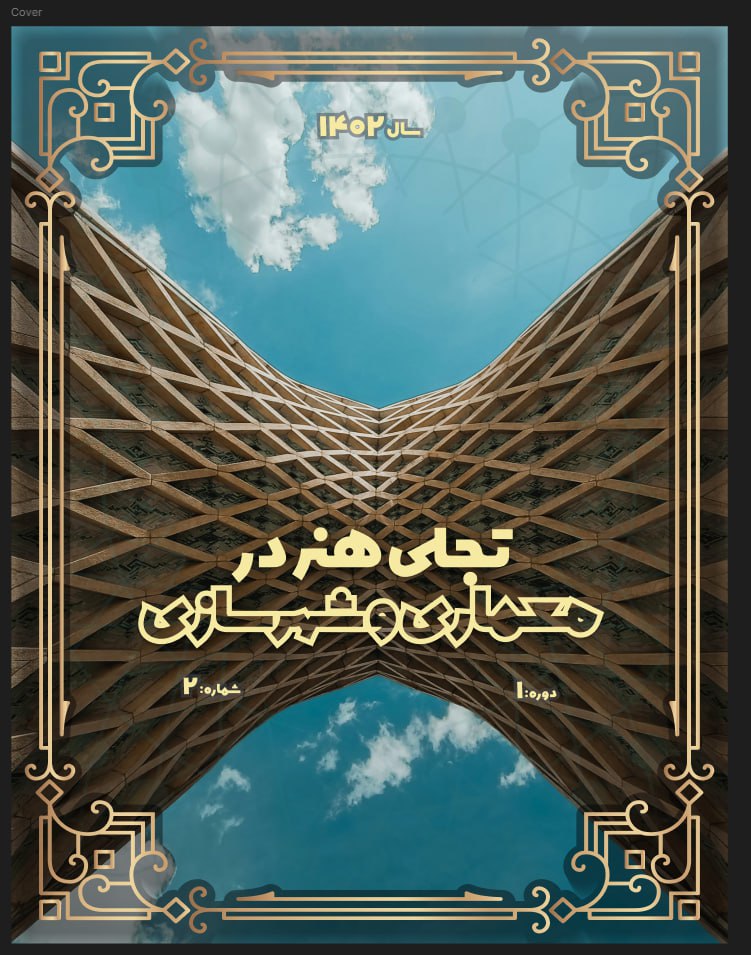Optimal Form Analysis of High-Rise Buildings to Enhance Urban Livability and Energy Efficiency Using Karamba Plugin
Keywords:
Parametric design, structural analysis, genetic algorithm, architectural form of tall buildings, energy efficiencyAbstract
In recent decades, the increasing development of high-rise buildings in metropolitan areas has become one of the primary indicators of vertical urban expansion. These structures are not only significant due to their specific design and construction requirements, but they also serve as prominent elements in the urban skyline, playing a key role in shaping spatial identity. One of the major challenges in high-rise design is selecting architectural forms that simultaneously satisfy aesthetic criteria, structural efficiency, and resilience to lateral loads such as earthquakes. The present study aims to examine the impact of floor plan geometry and vertical scaling on the structural performance of high-rise buildings using a genetic algorithm optimization approach within the Grasshopper environment, enhanced by the Karamba plugin. In this context, lateral displacement was analyzed as the seismic vulnerability index, and structural weight per unit area was assessed as the structural efficiency index, both serving as objective functions. Through multi-objective analysis and the definition of geometric variables within a parametric model, a set of optimal forms was generated. These optimized forms can serve as a basis for design decision-making depending on the priorities set by the designer. The findings indicate that forms with simple roof plans (triangular) and compact vertical scaling demonstrate superior performance in terms of seismic behavior and structural weight. Furthermore, the results show that the final design response is not a single definitive solution, but rather a set of "Pareto-optimal solutions," from which the designer can select the final form based on visual aesthetics, compatibility with climate, and project context. The final analysis of the models was conducted within the parametric Grasshopper environment, and the results can be generalized and applied to similar projects under diverse climatic and structural conditions.
Downloads
References
1. Azimi Aqdash M. High-Rise Building Regulations (Architectural Design): Novin Publications; 2016.
2. Khalvati S, Dehbashi Sharif M, Pourzargar MR. Examining the Role of Regulations in the Spatial Structure of High-Rise Residential Buildings in Tehran (Case Study: High-Rise Buildings from 1991 to 2020). 2021.
3. Samsami Hosseini A, editor The Necessity, Criteria, and Impacts of Tall Buildings. Proceedings of the Second International Conference on Tall Buildings; 2001; Tehran: Iran University of Science and Technology.
4. Jun H, Fei H. Research on multi-objective optimization of building energy efficiency based on energy consumption and thermal comfort. Building Services Engineering Research & Technology. 2024;45(4):391-411.
5. Bakhshi S, Chenaghlou MR, Rahimian FP, Edwards DJ, Dawood N. Integrated BIM and DfMA parametric and algorithmic design based collaboration for supporting client engagement within offsite construction. Automation in Construction. 2022;133:104015.
6. Tehran Urban Studies Planning Center. Development of Regulations for High-Rise Construction: Analytical Studies and Presentation of Proposed Regulations: PArt Consulting Engineers; 2013. 12-5 p.
7. Rezazadeh H, Shahroudi A, Jahani E, editors. The Impact of Various Shapes and Forms of Tall Buildings on Earthquake Force Distribution. Third Conference on Tall Buildings; 2016; Qarchak.
8. Sarban M, Valizadeh H, editors. Examining the Impact of Structural System Arrangement in Tall Buildings. National Conference on Architecture, Civil Engineering, Urban Planning, and Horizons of Islamic Art in the Second Step Statement of the Revolution; 2021; Tabriz.
9. Khodabandehloo A, Aghajani R. Optimal Design of Steel Diagrid Structures in Tall Buildings. Structural Analysis - Earthquake. 2018;15(2):39-46.
10. Javidan Nia G, Bamaniyan MR, Mahdavi Nejad MJ. The Impact of Plan Geometry and Twisting Architectural Form on the Damage to Non-Structural Components of Tall Buildings Against Earthquakes. Environmental Hazard Management. 2022.
11. Ardakani AR, Golabchi M, Hosseini SM, Alaqemandan M. Examining the Impact of the Form of Tall Buildings on Their Structural Stability with the Aim of Reducing Earthquake Hazards: Case Study on the Effect of Plan Shape Parameters. Environmental Hazard Management. 2017.
12. Khairnar P. Lightweight floor systems for tall buildings: A comparative analysis of structural material efficiencies. International Journal of High-Rise Buildings. 2023;12(2):145-52.
13. Preisinger C. Linking structure and parametric geometry. Archit Des. 2013;83(2):110-3DO - 10.1002/ad.564.
14. Asadbak M, Asadzadeh E, Asadzadeh M. Genetic Algorithm Book: Avalinha Publications; 2019.
15. Salata F, Ciancio V, Dell'Olmo J, Golasi I, Palusci O, Coppi M. Effects of local conditions on the multi-variable and multi-objective energy optimization of residential buildings using genetic algorithms. Applied Energy. 2020;260:114289.
16. Kazemi Sangdehi SP, Afghani Khoraskani R, Tahsildoust M. Examining the Impact of Plan Geometry of Tall Buildings with Diagrid Structures on Their Structural Behavior Against Lateral Earthquake Loads. Soffeh. 2020;30(1):43-58.
Downloads
Published
Submitted
Revised
Accepted
Issue
Section
License
Copyright (c) 2025 ولی زیوری افضل, مهرداد کریمی مشاور (نویسنده)

This work is licensed under a Creative Commons Attribution-NonCommercial 4.0 International License.









